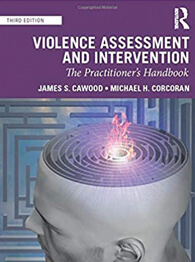Book Review: Violence Assessment and Intervention, Third Edition
Violence Assessment and Intervention: The Practitioner’s Handbook, Third Edition. By James S. Cawood and Michael H. Corcoran. Routledge; Routledge.com; 490 pages; $79.95.
 The first edition of Violence Assessment and Intervention: The Practitioner’s Handbook was published in 2003 and the second in 2009. Since then, the body of knowledge pertaining to assessing violence and developing intervention tactics has grown considerably, leading to this third edition.
The first edition of Violence Assessment and Intervention: The Practitioner’s Handbook was published in 2003 and the second in 2009. Since then, the body of knowledge pertaining to assessing violence and developing intervention tactics has grown considerably, leading to this third edition.
There are mixed messages about violence on a global level. It is accepted that rates of violence have been dropping around the world, possibly to the lowest levels recorded in history. This is cold comfort for those who are the victims of violence, however. While overall rates have dropped, the data shows that many people and organizations experience periodic violence, so researchers continue to examine the phenomenon of violence and using science and expertise to predict, assess, and intervene.
For those working and dealing with violence in numerous sectors—including security, healthcare, education, transportation, and others—violence is a very real issue that must be prepared for. In addition, legislation around occupational health and safety mandates that employers are legally and morally required to protect their employees.
This book is targeted to the violence prevention practitioner, and it is densely packed with research and practical tactics. This useful reference takes the reader through the violence assessment and intervention process, providing excellent information on a variety of themes including the different processes for assessment, dealing with victims of violence, intervention and case management, school violence, laws, regulations, legal concepts, and ethical issues.
Of particular interest in this well-written book is Chapter 7, “Organizational Influences: Personal and Professional.” This chapter shows a deeper understanding of some of the factors that need to be considered when conducting a violence assessment. It demonstrates a profound understanding of human psychology, motivations, and impacts that an organization can have upon the individual on a day-to-day basis and how the organization itself can impact both victims and offenders. Organizational culture is a powerful influence, potentially either positive or negative, and there must be context when conducting a risk assessment. This chapter, along with the rest, will force the assessor to think deeply about the assessment process.
This is a valuable book that contributes to our understanding of violence, its assessment, and intervention where appropriate.
Reviewer: Glen Kitteringham, CPP, has worked in the security industry since 1990. He is president of Kitteringham Security Group Inc., consulting with companies around the globe, and teaches security and emergency management courses at the University of Calgary and the Justice Institute of British Columbia.